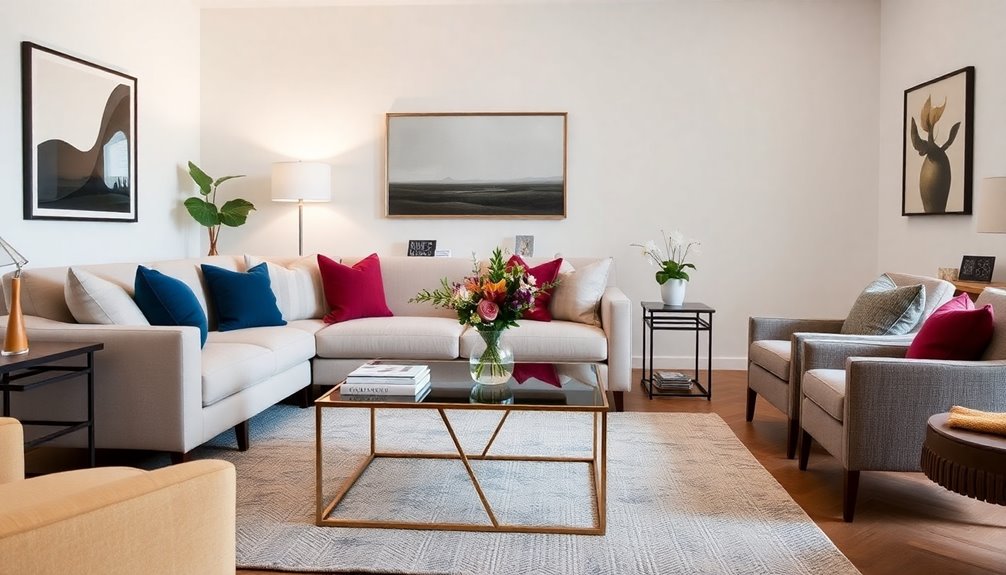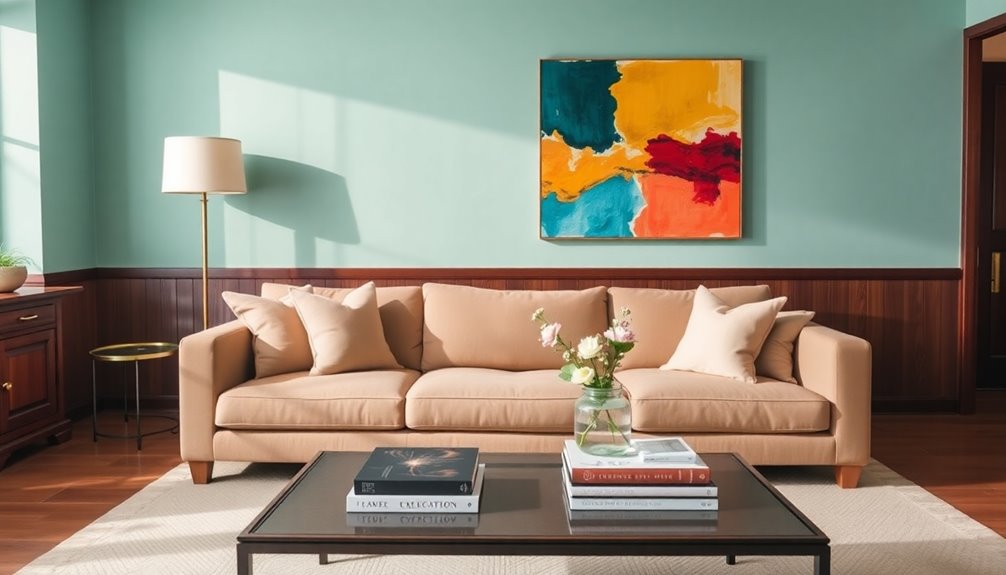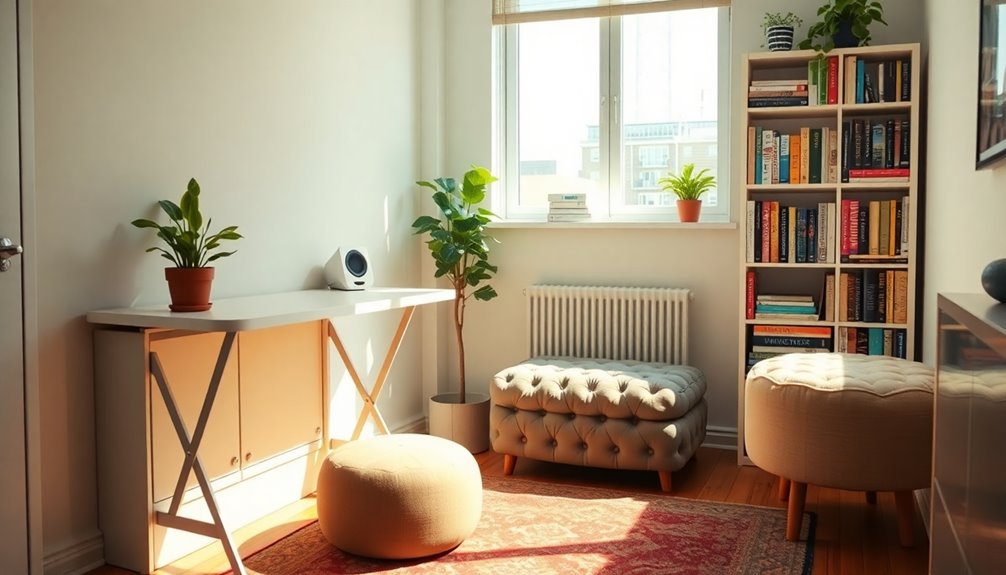To plan your space like a pro designer, start by establishing your budget and tracking all costs in real time, including a cushion for surprises. Next, gather design inspiration through mood boards and platforms like Pinterest. Create an effective room layout by measuring dimensions and sketching options. Select foundation furniture pieces that reflect your style while ensuring functionality. Choose colors and textures that create harmony and enhance mood. Finally, assess the flow and functionality of the space, making sure to keep pathways clear. Keep going, and you'll uncover more secrets to elevate your design game!
Key Takeaways
- Start with accurate room measurements and create a scaled floor plan to visualize furniture placement and layout effectively.
- Establish distinct activity zones using furniture arrangement and area rugs to enhance functionality and flow within the space.
- Prioritize key furniture pieces that define comfort and usability, focusing on versatile designs that adapt to various needs.
- Incorporate layered lighting with different sources to create ambiance and highlight decor while balancing intensity for specific activities.
- Use a mood board for color selection and design inspiration, ensuring all elements harmonize to create a cohesive aesthetic.
Establish Your Budget

Before diving into your design project, it's crucial to establish a clear budget to prevent overspending. Start by calculating the total cost of all project elements, including materials, labor, and furnishings. This initial step helps you understand what you're working with financially.
To cushion against unexpected costs that may arise during the design process, add an extra 10-20% to your budget.
Next, obtain at least three bids from contractors to compare costs and quality. This guarantees you make informed decisions regarding labor expenses, ultimately protecting your budget.
It's also a good idea to create a spreadsheet to track all expenditures related to the project. This organization tool lets you monitor your budget in real time, keeping you on top of your financial commitments.
Finally, prioritize expenditures by identifying vital items first. Allocate funds accordingly to guarantee critical aspects of your design are financially covered. Additionally, consider how you might establish clear savings goals to ensure your design project aligns with your overall financial strategy.
Gather Design Inspiration

Gathering design inspiration is an exciting step that sets the tone for your project. It's your chance to explore ideas and define your personal style before immersing yourself in purchases.
Start by creating a mood board, a visual compilation of elements that resonate with your aesthetic. This will clarify your direction and help you see how different pieces work together.
Here are three effective ways to gather design inspiration:
- Utilize Pinterest: Collect and organize images that inspire you. This platform allows for easy reference and helps you analyze trends in your saved pins.
- Identify a Key Object: Find one item that embodies your desired room style. Use its colors and materials as a foundation for your design choices. This object can serve as your anchor throughout the process. Consider selecting a piece made of durable materials to ensure longevity and resilience in your design. Incorporating natural materials like wood or bamboo can enhance the authenticity of your space. Additionally, consider how sustainable materials can contribute to a more eco-friendly design aesthetic.
- Explore Design Resources: Immerse yourself in social media and interior design blogs. These platforms offer diverse insights and ideas that can enhance your creative process, helping you refine your style and inform your color and decor selections. Consider incorporating boho decor ideas to enrich your design inspiration with vibrant colors and unique textures.
With these strategies, you'll gather a wealth of design inspiration to guide your project!
Create a Room Layout

To create a functional room layout, start by measuring your space—length, width, and height—while noting where windows and doors are located.
Once you have those dimensions, you can optimize your furniture arrangement using design software or graph paper for an accurate scaled layout.
This approach guarantees you make the most of your room while maintaining flow and functionality.
Measure Room Dimensions
Measuring your room's dimensions accurately is essential for creating an effective layout. Start by measuring the room's length, width, and height.
Don't forget to note the locations of windows, doors, and any architectural features that could influence your space planning. With these measurements in hand, you can create an accurate floor plan.
Here are three steps to help you visualize your space:
- Sketch it out: Use graph paper or design software like floorplanner.com to draft your room's layout. This visual aid will guide your design decisions.
- Use painter's tape: Outline potential furniture placements on the floor. This technique helps you assess available space and guarantees smooth flow within the room.
- Establish zones: Define different areas based on your measurements and intended activities. Use rugs or furniture placement to create functional zones, making sure larger items don't overwhelm the space. Incorporating open spaces can enhance the spacious feel of your design, aligning with the principles of modern farmhouse decor.
Optimize Furniture Arrangement
With your room dimensions and layout sketched out, it's time to optimize your furniture arrangement for both aesthetics and functionality. Start by accurately measuring your space and marking the locations of windows and doors on your floor plan. Use design tools like graph paper or free online apps such as Roomstyler to visualize your furniture placement, ensuring everything is to scale. Additionally, proper space management can help you maximize the usability of your room, much like how best home security systems utilize user-friendly interfaces to enhance functionality. Effective wall organization can also complement your furniture layout by enhancing vertical space utilization.
Next, prioritize creating distinct zones for various activities, like lounging or dining. This approach not only enhances the functional space but also helps maintain a clear traffic flow between furniture pieces. Aim for comfortable spacing—around 18 inches between sofas and coffee tables—to improve usability and avoid overcrowding the space.
Consider the natural focal points in your room, such as fireplaces or windows. Arrange your furniture symmetrically or around these elements to promote visual harmony. This will enhance the overall space feel, making it inviting and cohesive. Additionally, incorporating antiques in country decor can add character and charm to your space, making it even more unique and personalized.
Select Foundation Furniture

When planning your space, selecting the right foundation furniture is essential for creating a functional and inviting environment. Start by identifying key pieces that support the room's primary functions. Accurate measurements will help you choose the appropriate size for your foundation furniture, ensuring it complements the layout of the room.
Here are three essential pieces to evaluate:
- Sofa: A comfortable sofa sets the tone for relaxation and conversation. Additionally, consider selecting a sofa that incorporates natural materials to enhance the farmhouse aesthetic. A well-chosen sofa can also reflect modern farmhouse decor trends that emphasize comfort and style. Including cozy textiles can further enhance the inviting nature of your sofa.
- Coffee Table: This piece not only provides a surface for drinks and decor but also anchors the seating area.
- Dining Table: A versatile dining table accommodates meals, work, and gatherings, making it a central focus in your space.
Opt for neutral colors and simple designs for these items, as they offer versatility and make updates easier with accessories.
Pay attention to scale and proportion, ensuring each piece harmonizes with others and the overall space.
Finally, assess flexibility in your furniture arrangement by selecting multi-functional or modular pieces that adapt to your changing needs. Additionally, incorporating natural elements in your foundation furniture can promote tranquility and enhance the room's ambiance.
This thoughtful approach to space planning will create a balanced, inviting atmosphere in your home.
Choose Color and Decor

Choosing the right paint colors is essential for setting the mood of your space, so opt for shades that complement your vision. Incorporating natural elements like plants can also enhance the overall aesthetic and bring a sense of tranquility to your design.
Balance larger decor pieces with varied textures to create a cohesive look without overwhelming the room. Keep in mind that simplicity often leads to a more impactful design. Additionally, consider incorporating lighting design to enhance the overall ambiance and highlight your chosen decor.
Select Paint Colors Wisely
Selecting paint colors wisely sets the tone for your space, so consider the mood you want to create.
Start by choosing colors that resonate with your overall design vision. Use inspiration objects, like artwork or fabrics, to guide your selection and guarantee harmony in your color schemes.
Here are three tips to help you choose the perfect paint colors:
- Test Samples: Before committing, test large paint samples on your walls or poster boards. Observe how they look under different lighting conditions throughout the day. This will help you see the true colors in your space.
- Go Neutral: Consider using neutral shades like white, gray, or taupe. These versatile colors can enhance the perceived space without overwhelming the design and can serve as a backdrop for your decor.
- Create Depth: Look for colors with subtle undertones. This adds depth and complexity to your palette, ensuring your chosen paint colors harmonize with other elements in the room.
Balance Textures and Sizes
Once you've established a solid color foundation, balancing textures and sizes in your decor can elevate your space. Start by incorporating a variety of textures—think soft fabrics, hard surfaces, and natural elements. This mix creates visual interest and depth while maintaining a cohesive design theme.
Remember, it's vital to balance the sizes of your decor items. Opt for a few large pieces instead of multiple small ones; larger items make a more impactful statement and help reduce clutter.
When selecting decor colors, guarantee they complement the overall mood of the room. Neutral shades work wonders, providing versatility and allowing for easy updates with smaller accessories. For wall decor, consider groupings of smaller art pieces to create a cohesive gallery wall. Aim for arrangements that occupy at least two-thirds of the wall space for a balanced look.
Finally, maintain appropriate scale in your decor placement. Choose items that proportionately match the surrounding furniture and space dimensions to promote harmony and avoid overcrowding.
Assess Functionality and Flow

To create a functional and inviting space, start by evaluating the primary activities you'll engage in, whether it's lounging, dining, or entertaining. Understanding these functions is essential; it'll inform your furniture choices and layout, guaranteeing the room meets your needs.
Next, consider how the flow in the space will work. Keep pathways clear by allowing at least 18 inches between sofas and coffee tables. This spacing promotes easy movement and enhances overall functionality.
Here are three key steps to enhance flow and layout:
- Define Zones: Use area rugs or furniture arrangements to separate different activities within larger rooms. This helps create distinct areas for lounging, dining, or working.
- Evaluate Usability: Regularly engage in the activities that will take place in the room. This guarantees your furniture arrangement promotes comfort and accessibility.
- Identify Focal Points: Retain focal points that guide the flow and layout of the space. This makes it easier to create a balanced and harmonious design. Additionally, a well-planned layout can reduce stress levels, promoting a more tranquil and enjoyable environment.
Frequently Asked Questions
What Is the 3-5-7 Rule in Decorating?
Did you know that odd-numbered groupings in decor can enhance visual interest by up to 70%?
The 3-5-7 rule in decorating suggests you group items in odd numbers, placing the tallest piece at 7 inches, the medium at 5 inches, and the smallest at 3 inches.
This creates a dynamic look, drawing the eye to various heights while establishing balance.
What Is the 70/30 Rule in Interior Design?
The 70/30 Rule in interior design suggests that you dedicate 70% of your space to foundational elements like furniture and layout, while the remaining 30% should focus on decorative accents.
This balance prevents clutter and guarantees your room feels cohesive and inviting. By applying this rule, you can prioritize functionality and comfort, allowing your personal style to shine through without overwhelming the space.
It's a smart way to create harmony in your environment.
What Is the 2/3 Rule Sofa?
The 2/3 rule for sofas suggests that any artwork or decor you hang above your sofa should occupy about two-thirds of the sofa's width.
So, if your sofa is 90 inches wide, aim for around 60 inches of art or decor above it.
This guideline helps create balance and establishes a focal point, enhancing your room's overall aesthetic while ensuring your decor complements the furniture rather than overwhelming it.
What Are the 7 Rules of Interior Design?
When you immerse yourself in interior design, remember these seven essential rules:
First, achieve balance in your arrangements.
Next, establish a focal point that draws the eye.
Consider scale and proportion; choose items that fit your space.
Use a cohesive color palette and mix textures for depth.
Prioritize functionality to guarantee easy movement.
Finally, embrace personal style to make the space uniquely yours.
Following these guidelines will help create a harmonious and inviting environment.









